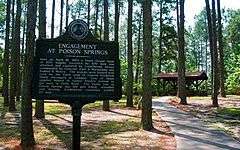Poison Springs Battleground State Park
|
Poison Springs Battleground State Park | |
|
National Park Service photo, 1994 | |
  | |
| Location | Ouachita County, Arkansas |
|---|---|
| Nearest city | Chidester, Arkansas |
| Coordinates | 33°38′18″N 93°0′29″W / 33.63833°N 93.00806°WCoordinates: 33°38′18″N 93°0′29″W / 33.63833°N 93.00806°W |
| Built | 1864 |
| NRHP Reference # | 69000036 |
| Significant dates | |
| Added to NRHP | December 3, 1969[1] |
| Designated NHL | April 19, 1994[2] |
Poison Springs Battleground State Park is an Arkansas state park located southeast of Bluff City. It commemorates the Battle of Poison Spring in the American Civil War, which was part of the 1864 Camden Expedition, an element of a Union Army initiative to gain control of Shreveport, Louisiana and get a foothold in Texas.
In the battle, which was fought on April 18, 1864, Confederates and Choctaw Indians attacked and overcame a supply wagon of Union soldiers. The term "poison spring" arises from the apocryphal story that Confederate soldiers poisoned nearby springwater. The battle hastened the failure of the Camden expedition, but also gained notoriety for the slaughter of African-American Union soldiers from Kansas by the Confederate forces, which took no African-American prisoners.
The site was listed on the National Register of Historic Places in 1969, and, with other sites, is part of the Camden Expedition Sites National Historic Landmark. It was declared part of the National Historic Landmark in 1994.[2][3][4]
The park includes about 85 acres (34 ha) of land, and lies on Arkansas Highway 76, about 14 miles (23 km) northwest of Camden. Highway 76 was the route which the Union supply train was on when it was roadblocked and attacked by the Confederate force. The improved portion of the park, with a picnic area and interpretive signs, is located on the north side of the highway. The battle, however, covered a much larger area, estimated at more than 9,000 acres (3,600 ha). The surrounding area is in roughly the same state as it was at the time of the battle, although land that was then under cultivation has since reverted to forest.[5]
The heavily wooded park features a small interpretive display and a shady trail. Sightings of deer and woodpeckers are common along the trail. The park provides an excellent example of the Gulf Coast forest region, consisting primarily of pine trees, but with some oak and with dogwood understory trees.
See also
- List of Arkansas state parks
- List of National Historic Landmarks in Arkansas
- National Register of Historic Places listings in Ouachita County, Arkansas
References
- ↑ National Park Service (2007-01-23). "National Register Information System". National Register of Historic Places. National Park Service.
- 1 2 "Camden Expedition Sites". National Historic Landmark summary listing. National Park Service. 2007-09-26.
- ↑ ""NHL nomination for Camden Expedition Sites", November 29, 1993, by Edward C. Bearss and James H. Charleton" (PDF). National Park Service. 1993-11-29.
- ↑ "Camden Expedition Sites--Accompanying 62 photos, from 1992-1993: Old U.S. Arsenal (6 photos), Confederate State Capitol (5 photos), Prairie de Ann Battlefield (7 photos), Jenkins' Ferry Battlefield (4 photos), Marks' Mills Battlefield (10 photos), Fort Southerland (5 photos), Poison Spring Battlefield (7 photos), Fort Lookout (9 photos), Elkin's Ferry Battlefield (9 photos)." (PDF). National Park Service. 1993-11-29.
- ↑ "NRHP nomination for Poison Spring State Park" (PDF). Arkansas Preservation. Retrieved 2014-05-24.
